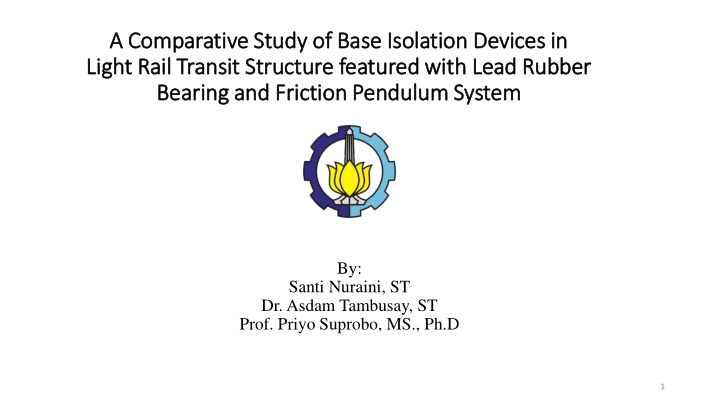



A Comparativ ive Study of Base Is Isola lation Devic ices in in Lig ight Rail il Transit Structure featured wit ith Lead Rubber Bearin ing and Fric iction Pendulum System By: Santi Nuraini, ST Dr. Asdam Tambusay, ST Prof. Priyo Suprobo, MS., Ph.D 1
BASE ISOLATION SYSTEM 1. extend the natural period of a structure as a means of providing additional damping and energy dissipation 2. preventing the structure to undergo severe damage under a major earthquake 2
TYPE OF BASE ISOLATION (Friction Pendulum System) (Lead Rubber Bearing) 3
LRB (Lead Rubber Bearing) This bearing includes a lead plug embedded at the centre of a laminated natural rubber structure, where the rubber incorporates the spring capability and the lead plug provides the damping capability. Generally, a separate damper is not required making it a good choice for areas with space constraints. Its hysteresis resembles elasto-plastic materials. The 4
FPS (Friction Pendulum System) The FPS consists of a spherical sliding surface and an articulated slider which is faced with a high pressure capacity bearing material. The bearing, which realize a pendulum system, may be installed also upside-down with the spherical surface facing down rather than up. In both installation methods the behavior is identical 5
STRUCTURE MODEL Pier Dimension : 2 x 2 m Pile Cap : 2 x 2 x 5 m 6 Pier Height : 16 m
SEISMIC DESIGN Design of seismic ground motion is determined based on the Indonesia earthquake provision SNI 1726:2012 [14] (drafted largely based on ASCE/SEI 7-10. ( PGA ) = 0.325 g mapped MCER Damping = 5% 0.2 ( SS ) = 0.50g 1 ( S1 ) = 0.25g 7
PUSHOVER ANALYSIS Pushover analysis was performed using nonlinear static displacement control. Only the self-weight of the Pushover point structure was considered in this simulation. The column tip was pushed up to one metre to foresee the nonlinear plateau of the structure and thereby allowing one to obtain the level of performance during plastic hinge mechanisms. 8
MATERIAL PROPERTIES 9
MATERIAL PROPERTIES R1=R4 R2=R3 4 3 h4 h3 h2 h1 2 1 d2=d3 d1=d4 10
PERFORMANCE LEVEL Base shear and displacement of LRB Base shear and displacement of FPS 11
ENERGY DISSIPATION In this current work, the improvement of energy dissipation controlled by seismic isolation system is inspected by the ratio of the structure without isolator (RL) and with isolators (FPS and LRB). According to Table, it is apparent that both seismic isolation devices stipulate higher energy dissipation with average improvement over 15%. 12
PLASTIC HINGE MECANISM 13
Respon Struktur 0.1 The result obtained indicates that structure with elastomer 0.08 0.06 0.04 engenders frequent peak facet without significant Displacement (m) 0.02 0 displacement reduction over time. Whilst in structures with -0.02 0 10 20 30 40 -0.04 seismic isolation devices, peak facet is found to be relatively -0.06 -0.08 diverse with the displacement reduced over time, signifying -0.1 FPS 1 FPS 2 FPS 3 that seismic isolators provide adequate damping on isolating Time Period (Sec) seismic forces prior to transferring to the column and thereby 0.1 Displacement (m) leading to alleviation of base shear at the column. 0.05 0 0 10 20 30 40 -0.05 -0.1 LRB 3 LRB 1 LRB 2 Time Period (Sec) 0.1 0.05 Displacement (m) 0 0 10 20 30 40 -0.05 -0.1 Time Period (Sec) 14
CONCLUSIONS 1. The application of seismic bearings is found to be helpful in safeguarding the level of performance point of the structure within the range of IO-LS. 2. It is now understood that the use of pendulum bearings indeed provides more ductile response than that of lead rubber bearing. It can also be associated with higher energy dissipation maintained by pendulum bearings. 3. Design of LRT structure has proven to meet the general conception of an earthquake-resistant structure where the development of plastic hinge occurs initially at the column and propagate toward the first two metres of bored pile foundations. 4. It is found that pendulum bearings provides as better response in terms of isolating the seismic force, leading to a decrease of magnitude of base shear at the column base adjacent to the pile cap. 15
THANKYOU 16
Recommend
More recommend